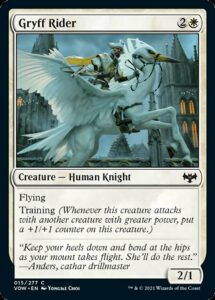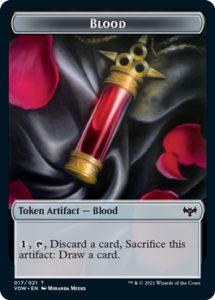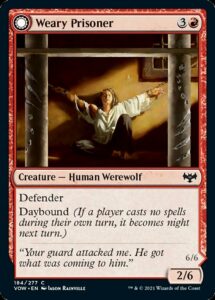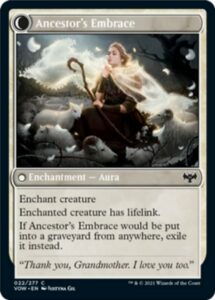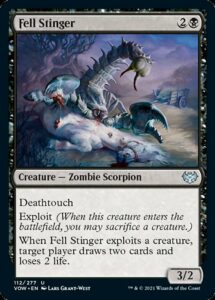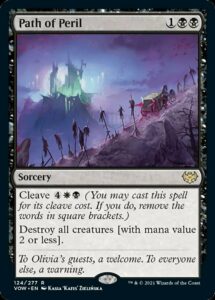Crimson Vow preview season last barely longer than a week, meaning we’ve had an explosion of card reveals. Next week, we’ll get to play with the cards both on Arena and (where safe) at our local game stores. But while we’ve still got plenty more unrevealed cards, we now know every mechanic in the set. As with Midnight Hunt, there’s a high density of mechanics. And as ever, Drawing Live is a big fan of mechanics. So let’s look at each of them and see how they measure up.
Training
On the face of it, Training seems very similar to Mentor (probably my favorite non-evergreen combat mechanic of all time). But it’s actually the inverse of Mentor. It presents an opposite (and arguably simpler) deckbuilding puzzle. Mentor encourages you to fill your deck with cheap, small creatures to maximize Mentoring moments. That’s what aggressive decks normally want to do, but it makes low power creatures far more valuable than normal.
Training, on the other hand, rewards playing with higher power creatures, which is what basically all decks prefer—when in doubt, higher power is better than lower power. Also, if Training is primarily on 1 and 2 power creatures, it’s a self-solving puzzle where the majority of creatures in your deck get you that first +1/+1 counter and the challenge lies in getting a second—though if you’re already attacking uncontested for two straight turns with two or more creatures, you’re already winning and the +1/+1 counter is just win-more. This aspect makes me cooler on Training despite it resembling a mechanic I adore.
On the other other hand, the fact that Training presenting a simpler puzzle makes it much smoother to play with. When you attack, Training immediately triggers. It can’t be interrupted by shrinking a creature’s power, it doesn’t require targets, and it doesn’t matter the order in which you stack multiple Training triggers. Mentor, on the other hand, can involve complicated stacking of triggered abilities, where you sometimes need the Mentor abilities to resolve in a specific order to not accidentally turn off the chain. Having a clean, intuitive implementation is a huge advantage for Training.
Training’s generic name and clean implementation make me wonder if it’s a candidate for quickly becoming a repeat or even Deciduous mechanic. And there’s also the question of how much mana Training is worth. Given the few cards seen at time of writing, Training looks like it’s in the 0.25 mana range (aka almost free) where mechanics like Reach and Prowess sit. All in all, it seems like a fine workhorse mechanic and we’ll see how it plays out come Crimson Vow prerelease next week.
Blood Tokens
A while back, we discussed alternate economies in Magic—game objects like Clue, Treasure, and Food tokens. Now, another such token joins the mix. Blood is perhaps the most complicated token to employ on its own, since it involves balancing risk and reward. All other tokens of course test that as well—”do I eat my Food now or save it for if I draw my Cauldron Familiar?” or “do I use my Treasure immediately as ramp or save it if I draw a card of my missing color?”
Blood has the additional asks of having you evaluate the cards in your hand relative to the cards in your deck. There’s an easy heuristic, of course: discard spells if you’re looking for lands in the early game, discard lands and weak or situational spells in the late game. But no other artifact token has you care so much about how you use their default mode. Blood seems akin to Food in that it’ll often be used by a card in lieu of (or addition to) its normal effect. That makes sense, since Food and Blood generate weaker outputs on their own than Clues and Treasures do. That also makes the mechanic harder to evaluate, since so much of its power lies in the contextual cards that use Blood rather than Blood itself.
As a mechanic in a vampire-focused set, I’m split on how excited I am about Blood. It’s super on theme—of course vampires are guzzling goblets of gore at Olivia’s nuptials. And it plays quite well with the Madness-focused vampires of Shadows over Innistrad. But it does feel odd that for two sets in a row, Vampires don’t get a creature keyword (they’re the only tribe that didn’t a keyword in Midnight Hunt) and their two strategies don’t intrinsically interact with each other at all.
If anything, Blood is somewhat antisynergistic with the pseudo-Bloodthirst vampires of Midnight Hunt (since they’re so reliant on curving out). But again, the mechanic is contextual—it’s all about how easy Blood is to create, how strong the Blood economy is, and whether decks will be easily able to employ Blood directly. Even if Blood isn’t that easy to convert into other resources, it should serve as a strong smoothing mechanic, and every set wants at least one.
Daybound & Nightbound
It’s no surprise that the major update to Werewolves returns from Midnight Hunt. Nor would it be surprising for day and night to take a less prominent role in Crimson Vow.
I’ve already discussed this mechanic at length. In short, I think Daybound/Nightbound is better than the previous werewolf mechanic even though I prefer the older mechanic (mostly because of how the two mechanics play in Cube). With the few cards revealed at time of writing, it doesn’t look like anything’s changed with the mechanic, so there’s not much to say now.
Disturb
Last week, I was tepid on Disturb. It like the concept and the stories that it can tell, but I disliked how the execution was mostly small creatures dying into small flying creatures. This was mostly a necessity because Innistrad spirits have to fly, are traditionally small, and the card advantage inherent to Disturb makes big creatures prohibitively expensive. But just because it had to be done this way doesn’t make me higher on the execution.
Here, Disturb tells a very different story. Beneficial geists leave vestiges of themselves to aid the living. I like that narrative a lot, where a world plunged into neverending night, with diminished protection from angels, see spirits rising up to help. And I like the mechanical execution, where dead creatures literally share their abilities with the living. Rather than dealing with the inherent card advantage of additional creatures, this twist on Disturb enables players to fill their decks with normally unplayable auras for free. It reminds me a bit of how Learn enabled decks full of more instants and sorceries than they’d normally be able to contain. It’s awesome when mechanics like this can let people play cards they normally never would.
I don’t expect Disturb to be especially powerful, but not all mechanics have to or even should be. Getting little creature auras for free might not be alluring to all, which will make it easier to assemble a coherent Spirit-focused deck. Plus, Blood will make it even easier to get effective card advantage by discarding Disturb cards.
Exploit
Training is the direct mirror of Mentor. Exploit (returning from Dragons of Tarkir) is a more of a funhouse mirror reflection of the original Skaab mechanic on cards like Makeshift Mauler. Rather than requiring corpses for zombie construction, you can choose to feed your already-assembled zombies fresh meat to cast spells.
Mechanically, Exploit makes a ton of sense on Innistrad. The sacrifice theme affectionately known as Aristocrats was born on Innistrad. Moreover, Exploit works splendidly with Decayed zombies. But thematically, I’m torn. It makes sense for your zombies to be better if you graft extra parts onto them, and it’s not like skaabs ever cared about what you made them out of.
But I’m also familiar with Exploit as a form of blood magic. Having a zombie scorpion consume something for power feels more Amonkhet or Tarkir to me than a stitcher using extra parts to make an extra magical zombie scorpion. This is a nitpick, not a serious criticism, but the execution just feels off to me.
Cleave
While we’ve essentially seen Cleave already in both the Great Designer Search and Mystery Booster playtest cards, it still reads unlike anything else. It looks like lines of code—like a card that editing wasn’t quite finished with. But it’s a Mel card through and through: appreciating Cleave is entirely about enjoying mechanical design and ignoring its lack of flavor.
Initially, I wasn’t enamored with Cleave—it reads so weirdly. But then I saw how the cool, varied ways Wizards crafted these modifiable spells. Path of Peril simply upgrades into a more powerful version of the same effect. Inspired Idea Cleaves to eliminate a downside. Lantern Flare takes two completely different inputs, effectively being a split card. Those are three strong uses of affordances and they make me excited to see more such cards, even if it’s going to take me a bit of time to get used to the formatting.
I’m not in love with the name, though. You’re literally Cleaving text from the physical card, which could perhaps be immersion breaking. Granted, Cycling can be criticized the exact same way, so again, this is more nitpick than complaint. Still, I do wish it were a bit more generic a word just because Cleave sounds like it’s a combat keyword.
And that’s every mechanic in Innistrad: Crimson Vow. I was surprised by how Midnight Hunt’s mechanics played out (most notably how much more I liked Decayed than when I first read it) and I’m looking forward to experiencing all these new mechanics firsthand. But until then, I’ll be imagining the other kinds of designs we might see spoiled this week.
And, as always, thanks for reading.
Zachary Barash is a New York City-based game designer and the commissioner of Team Draft League. He designs for Kingdom Death: Monster, has a Game Design MFA from the NYU Game Center, and does freelance game design. When the stars align, he streams Magic (but the stars align way less often than he’d like).

